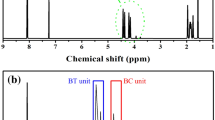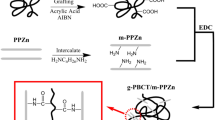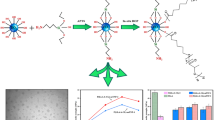Abstract
The fully biodegradable polymer blends remain challenges for the application due to their undesirable comprehensive performance. Herein, remarkable combination of superior mechanical performance, bacterial resistance, and controllable degradability is realized in the biodegradable poly(L-lactide)/poly(butylene succinate) (PLLA/PBSU) blends by stabilizing the epoxide group modified titanium dioxide nanoparticles (m-TiO2) at the PLLA-PBSU interface through reactive blending. The m-TiO2 can not only act as interfacial compatibilizer but also play the role of photodegradation catalyst: on the one hand, binary grafted nanoparticles were in situ formed and stabilized at the interface to enhance the compatibility between polymer phases. As a consequence, the mechanical properties of the blend, such as the elongation at break, notched impact strength and tensile yield strength, were simultaneously improved. On the other hand, antibacterial and photocatalytic degradation performance of the composite films was synergistically improved. It was found that the m-TiO2 incorporated PLLA/PBSU films exhibit more effective antibacterial activity than the neat PLLA/PBSU films. Moreover, the analysis of photodegradable properties revealed that that m-TiO2 nanoparticles could act as a photocatalyst to accelerate the photodegradation rate of polymers. This study paves a new strategy to fabricate advanced PLLA/PBSU blend materials with excellent mechanical performance, antibacterial and photocatalytic degradation performance, which enables the potential utilization of fully degradable polymers.
Similar content being viewed by others
References
Ulery, B. D.; Nair, L. S, Laurencin, C. T. Biomedical applications of biodegradable polymers. J. Polym. Sci., Part B: Polym. Phys. 2014, 49, 832–864.
Van de Velde, K.; Kiekens, P. Biopolymers: overview of several properties and consequences on their applications. Polym. Test. 2002, 21, 433–442.
Zhao, P.; Liu, W.; Wu, Q.; Ren, J. Preparation, mechanical, and thermal properties of biodegradable polyesters/poly(lactic acid) blends. J. Nanomater. 2010, 4, 287082.
Sinha Ray, S. Polylactide-based bionanocomposites: a promising class of hybrid materials. Acc. Chem. Res. 2012, 45, 1710–1720.
Liminana, P.; Garcia-Sanoguera, D.; Quiles-Carrillo, L.; Balart, R.; Montanes, N. Development and characterization of environmentally friendly composites from poly(butylene succinate) (PBS) and almond shell flour with different compatibilizers. Compos. Part B 2018, 144, 153–162.
Xu, J.; Guo, B. Poly(butylene succinate) and its copolymers: research, development and industrialization. Biotechnol. J. 2010, 5, 1149–1163.
Ojijo, V.; Sinha Ray, S.; Sadiku, R. Role of specific interfacial area in controlling properties of immiscible blends of biodegradable polylactide and poly[(butylene succinate)-co-adipate]. ACS Appl. Mater. Interfaces 2012, 4, 6690–6701.
Yokohara, T.; Yamaguchi, M. Structure and properties for biomass-based polyester blends of PLA and PBS. Eur. Polym. J. 2008, 44, 677–685.
Supthanyakul, R.; Kaabbuathong, N.; Chirachanchai, S. Random poly(butylene succinate-co-lactic acid) as a multi-functional additive for miscibility, toughness, and clarity of PLA/PBS blends. Polymer 2016, 105, 1–9.
Di Lorenzo, M. L. Poly(L-lactic-acid)/poly(butylene succinate) biobased biodegradable blends. Polym. Rev. 2021, 61, 457–492.
Wang, Y. P.; Xiao, Y. J.; Duan, J.; Yang, J. H.; Wang, Y.; Zhang, C. L. Accelerated hydrolytic degradation of poly(lactic acid) achieved by adding poly(butylene succinate). Polym. Bull. 2016, 73, 1067–1083.
Imre, B.; Pukánszky, B. Compatibilization in bio-based and biodegradable polymer blends. Eur. Polym. J. 2013, 49, 1215–1233.
Harada, M.; Ohya, T.; Iida, K.; Hayashi, H.; Hirano, K.; Fukuda, H. Increased impact strength of biodegradable poly(lactic acid)/poly(butylene succinate) blend composites by using isocyanate as a reactive processing agent. J. Appl. Polym. Sci. 2007, 106, 1813–1820.
Hu, X.; Su, T.; Li, P.; Wang, Z. Blending modification of PBS/PLA and its enzymatic degradation. Polym. Bull. 2018, 75, 533–546.
Srimalanon, P.; Prapagdee, B.; Markpin, T.; Sombatsompop, N. Effects of DCP as a free radical producer and HPQM as a biocide on the mechanical properties and antibacterial performance of in situ compatibilized PBS/PLA blends. Polym. Test. 2018, 67, 331–41.
Su, S.; Kopitzky, R.; Tolga, S.; Kabasci, S. Polylactide (PLA) and its blends with poly(butylene succinate) (PBS): a brief review. Polymers 2019, 11, 1193.
Zhang, B.; Sun, B.; Bian, X.; Li, G.; Chen, X. High melt strength and high toughness PLLA/PBS blends by copolymerization and in situ reactive compatibilization. Ind. Eng. Chem. Res. 2017, 56, 52–62.
Ji, D.; Liu, Z.; Lan, X.; Wu, F.; Xie, B.; Yang, M. Morphology, rheology, crystallization behavior, and mechanical properties of poly(lactic acid)/poly(butylene succinate)/dicumyl peroxide peactive blends. J. Appl. Polym. Sci. 2014, 131, 39580.
Chen, G. X.; Kim, H. S.; Kim, E. S.; Yoon, J. S. Compatibilization-like effect of reactive organoclay on the poly(L-lactide)/poly(butylene succinate) blends. Polymer 2005, 46, 11829–11836.
Li, X.; Fu, Z.; Gu, X.; Liu, H.; Li, Y. Interfacially located nanoparticles: barren nanorods versus polymer grafted nanorods. Compos. Part B 2020, 198, 108153.
Phetwarotai, W.; Phusunti, N. Preparation and characteristics of poly(butylene adipate-co-terephthalate)/polylactide blend films via synergistic efficiency of plasticization and compatibilization. Chinese J. Polym. Sci. 2019, 37, 68–78.
Fu, Z.; Wang, H.; Zhao, X.; Li, X.; Gu, X.; Li, Y. Flame-retarding nanoparticles as the compatibilizers for immiscible polymer blends: simultaneously enhanced mechanical performance and flame retardancy. J. Mater. Chem. A 2019, 7, 4903–4912.
Lyly Nyl, I.; Aziz, A. F.; Habibah, Z.; Zaihidi, M. M.; Abdullah, M. H.; Herman, S. H.; Noor, U. M.; Rusop, M. Optical properties and surface morphology of PMMA: TiO2 nanocomposite thin films. Adv. Mater. Res. 2011, 364, 105–109.
Zhao, X.; Wang, H.; Fu, Z. Enhanced interfacial adhesion by reactive carbon nanotubes: new route to high-performance immiscible polymer blend nanocomposites with simultaneously enhanced toughness, tensile strength, and electrical conductivity. ACS Appl. Mater. Interfaces 2018, 10, 8411–8416.
Huang, X.; Zheng, Y.; Jiang, P.; Yin, Y. I. Influence of nanoparticle surface treatment on the electrical properties of cycloaliphatic epoxy nanocomposites. IEEE Trans. Dielectr. Electr. Insul. 2010, 17, 635–643.
Cho, H. J.; Jung, D. The application of TiO2 hollow spheres on dye-sensitized solar cells. Bull. Korean Chem. Soc. 2011, 32, 4382–4386.
Calia, A.; Lettieri, M.; Masieri, M.; Pal, S.; Licciulli, A.; Arima, V. Limestones coated with photocatalytic TiO2 to enhance building surface with self-cleaning and depolluting abilities. J. Cleaner Prod. 2017, 165, 1036–1047.
Cervantes-Avilés, P.; Ida, J.; Toda, T.; Cuevas-Rodríguez, G. Effects and fate of TiO2 nanoparticles in the anaerobic treatment of wastewater and waste sludge. J. Environ. Manage. 2018, 222, 227–233.
Sani, M. A.; Ehsani, A.; Hashemi, M. Whey protein isolate/cellulose nanofibre/TiO2 nanoparticle/rosemary essential oil nanocomposite film: its effect on microbial and sensory quality of lamb meat and growth of common foodborne pathogenic bacteria during refrigeration. Int. J. Food Microbiol. 2017, 251, 8–14.
Zhang, X.; Xiao, G.; Wang, Y.; Zhao, Y.; Su, H.; Tan, T. Preparation of chitosan-TiO2 composite film with efficient antimicrobial activities under visible light for food packaging applications. Carbohydr. Polym. 2017, 169, 101–107.
Xing, Y.; Li, X.; Zhang, L.; Xu, Q.; Che, Z.; Li, W.; Bai, Y.; Li, K. Effect of TiO2 nanoparticles on the antibacterial and physical properties of polyethylene-based film. Prog. Org. Coat. 2012, 73, 219–224.
Chawengkijwanich, C.; Hayata, Y. Development of TiO2 powder-coated food packaging film and its ability to inactivate escherichia coli in vitro and in actual tests. Int. J. Food Microbiol. 2008, 123, 288–292.
Luo, S.; Zhang, P.; Gao, D. Preparation and properties of antimicrobial poly(butylene adipate-co-terephthalate)/TiO2 nanocomposites films. J. Macromol. Sci. Part B Phys. 2020, 59, 248–261.
Venkatesan, R.; Rajeswari, N. TiO2 Nanoparticles/poly(butylene adipate-co-terephthalate) bionanocomposite films for packaging applications. Polym. Adv. Technol. 2017, 28, 1699–1706.
Antunes, A.; Popelka, A.; Aljarod, O.; Hassan, M. K.; Luyt, A. S. Effects of rutile TiO2 nanoparticles on accelerated weathering degradation of poly(lactic acid). Polymers 2020, 12, 1096.
Zhang, Y.; Han, J.; Wu, S.; Qi, Z.; Xu, J.; Guo, B. Synthesis, physical properties and photodegradation of functional poly(butylene succinate) covalently linking UV stabilizing moieties in molecular chains. Colloids Surf. A 2017, 524, 160–168.
Luo, Y.; Cao, Y.; Guo, G. Effects of TiO2 nanoparticles on the photodegradation of poly(lactic acid). J. Appl. Polym. Sci. 2018, 135, 46509.
Fa, W.; Gong, C.; Tian, L.; Peng, T.; Zan, L. Enhancement of photocatalytic degradation of poly(vinyl chloride) with perchlorinated iron (II) phthalocyanine modified nano-TiO2. J. Appl. Polym. Sci. 2011, 122, 1823–1828.
Miyauchi, M.; Li, Y.; Shimizu, H. Enhanced degradation in nanocomposites of TiO2 and biodegradable polymer. Environ. Sci. Technol. 2008, 42, 4551–4554.
Zhang, H.; Li, F.; Zhu, H. Immobilization of TiO2 nanoparticles on PET fabric modified with silane coupling agent by low temperature hydrothermal method. Fibers Polym. 2013, 14, 43–51.
Wang, H.; Fu, Z.; Zhao, X. Reactive nanoparticles compatibilized immiscible polymer blends: synthesis of reactive SiO2 with long poly(methyl methacrylate) chains and the in situ formation of Janus SiO2 nanoparticles anchored exclusively at the interface. ACS Appl. Mater. Interfaces 2017, 9, 14358–14370.
Basha, R. K.; Konno, K.; Kani, H.; Kimura, T. Water vapor transmission rate of biomass based film materials. Engineering in Agriculture, Environment and Food. 2011, 4, 37–42.
Decol, M.; Pachekoski, W. M.; Becker, D. Compatibilization and ultraviolet blocking of PLA/PCL blends via interfacial localization of titanium dioxide nanoparticles. J. Appl. Polym. Sci. 2018, 135, 44849.
Le, H. H.; Osswald, K.; Ilisch, S.; Hoang, X. T.; Heinrich, G.; Radusch, H. J. Master curve of filler localization in rubber blends at an equilibrium state. J. Mater. Sci. 2012, 47, 4270–4281.
Cao, Y.; Xu, P.; Lv, P; Lemstra, P. J.; Cai, X.; Yang, W.; Dong, W.; Chen, M.; Liu, M.; Ma, P. Excellent UV resistance of polylactide by interfacial stereocomplexation with double-shell-structured TiO2 nanohybrids. ACS Appl. Mater. Interfaces 2020, 12, 49090–49100.
Acknowledgments
This study was financially supported by the Major Project of Natural Science Foundation of Zhejiang Province of China (No. LD19E030001) and National Nature Science Foundation of China (No. 51903071).
Author information
Authors and Affiliations
Corresponding author
Electronic supplementary material
10118_2021_2632_MOESM1_ESM.pdf
Reactive TiO2 Nanoparticles Compatibilized PLLA/PBSU Blends: Fully Biodegradable Polymer Composites with Improved Physical, Antibacterial and Degradable Properties
Rights and permissions
About this article
Cite this article
Gu, XY., Hu, LM., Fu, ZA. et al. Reactive TiO2 Nanoparticles Compatibilized PLLA/PBSU Blends: Fully Biodegradable Polymer Composites with Improved Physical, Antibacterial and Degradable Properties. Chin J Polym Sci 39, 1645–1656 (2021). https://doi.org/10.1007/s10118-021-2632-x
Received:
Accepted:
Published:
Issue Date:
DOI: https://doi.org/10.1007/s10118-021-2632-x




